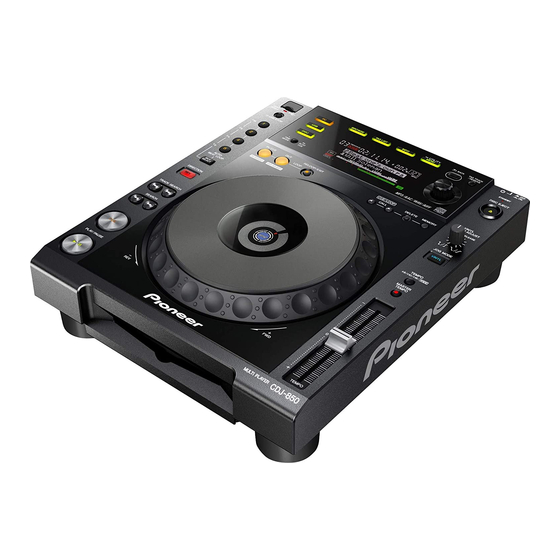Pioneer CDJ-850 Manual de Instruções - Página 8
Procurar online ou descarregar pdf Manual de Instruções para Leitor de CD Pioneer CDJ-850. Pioneer CDJ-850 32 páginas. Cdj-850 owner's manual (french)
Também para Pioneer CDJ-850: Manual de início rápido (3 páginas), (Inglês) Manual do utilizador (32 páginas)

About USB devices
This unit supports USB mass storage class USB devices (external
hard disks, portable flash memory devices, digital audio players, etc.).
Folder layers
Max. 8 layers
Max. number of
1 000 folders
folders
Max. number of
10 000 files (1 000 files for files not managed by rekordbox)
files
Supported file
FAT16, FAT32 and HFS+ (NTFS is not supported.)
systems
When there are many folders or files, some time may be required for loading.
Folders and files exceeding the limits cannot be displayed.
USB devices that cannot be used
! Optical disk type devices such as external DVD/ CD drives, etc., are
not supported.
! USB hubs cannot be used.
Playable music file formats
This unit supports music files in the formats shown below.
Type
File extension
MP3
.mp3
AAC
.m4a, .aac and .mp4
WAV
.wav
AIFF
.aif, .aiff
About MP3 files
MP3 files can have a constant bit rate (CBR) or a variable bit rate
(VBR). Both types of files can be played on the CDJ-850, but the search
and super fast search functions are slower with VBR files. If your prior-
ity is operability, we recommend recording MP3 files in CBR.
8
En
Compatible
Bit depth
formats
MPEG-1
16 bit
MPEG-4 AAC LC
16 bit
WAV
16 bit, 24 bit
AIFF
16 bit, 24 bit
Cautions on using USB devices
! Some USB devices may not operate properly. Please note that
Pioneer will accept no responsibility whatsoever for loss of data
recorded on USB devices.
! It may happen that, when a current above the allowable level is
detected in this unit's USB port, the [USB STOP] indicator flashes,
the power supply to the USB device is cut off and communications
with the USB device are interrupted. To restore normal operation,
disconnect the USB device from this unit. Avoid reusing USB
devices for which an excess current has been detected. If normal
operation is not restored (if communications cannot be estab-
lished) after the above procedure is performed, try turning off this
unit's power then turning it back on.
! If multiple partitions are set for the USB device, the device may not
be recognized.
! USB devices equipped with flash card readers may not operate.
! Depending on the USB device you are using, the desired perfor-
mance may not be achieved.
Bit rate
Sampling frequency
32 kbps to 320 kbps
32 kHz, 44.1 kHz, 48 kHz
16 kbps to 320 kbps
32 kHz, 44.1 kHz, 48 kHz
—
44.1 kHz, 48 kHz
—
44.1 kHz, 48 kHz
About AAC files
! AAC is the abbreviation of "Advanced Audio Coding", a basic
format of audio compression technology used for MPEG-2 and
MPEG-4.
! The file format and extension of AAC data depends on the applica-
tion used to create the data.
! In addition to AAC files with the extension ".m4a" encoded with
iTunes®, files with the extensions ".aac" and ".mp4" can also be
played. Note, however, that copyright-protected AAC files pur-
chased for example at the iTunes Music Store cannot be played.
Also, some files may not be playable, depending on the version of
iTunes used for encoding.
Encoding
method
CBR, VBR
CBR, VBR
Uncompressed PCM
Uncompressed PCM
